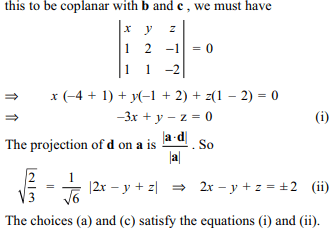1. Let \[a=\cos \alpha i+\sin\alpha j,b=\cos \beta i+\sin\beta j,c=\cos \gamma i+\sin\gamma j,0\leq \gamma,\beta,\gamma< 2\pi\]
If a . c = b . c = – \[\sqrt{3}\] a . b, then a . b is equal to
a) \[-\frac{1}{3}\]
b) \[-\frac{1}{2}\]
c) \[\frac{1}{2}\]
d) Both a and c
Explanation:

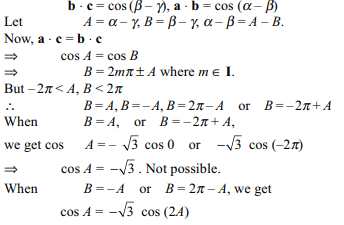

2. Let a, b, c be the vectors
\[a=i+\left(\cos\theta\right)j+\left(\cos2\theta\right)k\]
\[b=\left(\cos\theta\right)i+\left(\cos2\theta\right)j+\left(\cos3\theta\right)k\]
\[c=\left(\cos2\theta\right)i+\left(\cos3\theta\right)j+\left(\cos4\theta\right)k\]
and let \[f\left(\theta\right)=\left[a b c\right]\] , then
a) \[f\left(\frac{\pi}{2}\right)=0\]
b) \[f\left(\frac{3\pi}{2}\right)=0\]
c) \[f\left(\pi+\theta\right)=-f\left(\pi-\theta\right)\]
d) All of the Above
Explanation:


3. Let ABC be a triangle, and
let \[p=\left(\sin A\right)i+\left(\sin B\right)j\]
\[q=\left(\cos B\right)i+\left(\cos A\right)j\]
be two vectors such that p . q = sin 2c. If sin A, sin C,
sin B are in A.P.,
and AC . (BA – CA) = 32, then
a) \[\angle BCA=\pi/3\]
b) \[\triangle ABC\] is equilateral \[\triangle \]
c) in radius of \[\triangle ABC\] is \[\frac{4}{3}\sqrt{3}\]
d) All of the Above
Explanation: p \[\cdot\] q = sin A cos B + sin B cos A



4. Let AB be a chord of the unit circle with
centre O and let length of AB = 2l, where 0 < l < 1. If point
P on the unit circle is such that \[\mid AP\mid\mid BP\mid=2\left(1-\sqrt{1-l^{2}}\right)\]
then
a) P can be mid-point of arc (AB)
b) \[\angle POA=\sin^{-1}\left(l\right)\]
c) arc \[\left(AB\right)=2\sin^{-1}\left(l\right)\]
d) All of the Above
Explanation: Suppose OA is the x-axis, the OA = i. Let


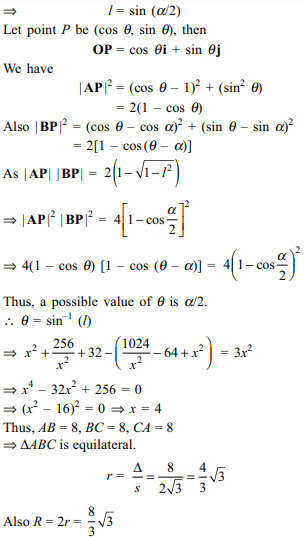
5. Let \[n\epsilon N, n\geq 2\] . Given (n + 2) points O \[A_{0},A_{1},...,A_{n}\] in
the XY-plane such that \\[\angle A_{k-1}OA_{k}=\pi/n,\left(1\leq k\leq n\right),\angle OA_{k-1}A_{k}=\angle OA_{0}A_{1}\left(2\leq k\leq n\right)\]
If \[\mid OA_{0}\mid=1,\mid OA_{1}\mid=1+\frac{1}{n}\] then
a) \[\mid OA_{k}\mid=\left(1+\frac{1}{n}\right)^{k}\left(O\leq k\leq n\right)\]
b) \[\mid A_{0}A_{1}\mid^{2}=4\left(1+\frac{1}{n}\right)\sin^{2}\left(\frac{\pi}{2n}\right)+\frac{1}{n^{2}}\]
c) \[\lim_{n \rightarrow \infty}\sum_{r=1}^n \mid A_{r-1}A_{r}\mid=\left(e-1\right)\sqrt{\pi^{2}+1}\]
d) All of the Above
Explanation:

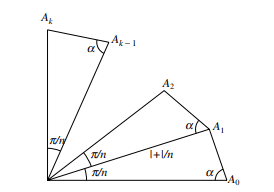
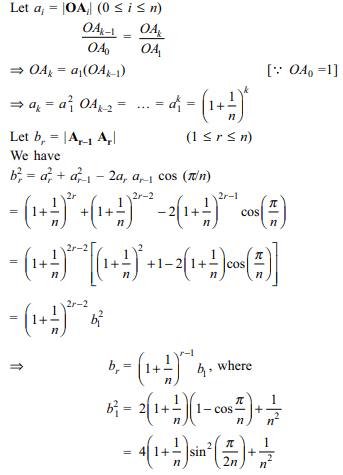
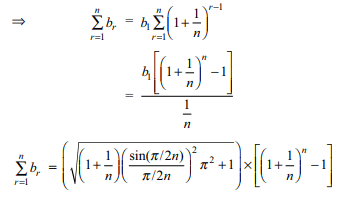

6. The vectors \[\lambda i+j+2k,i+\lambda j-k\] and
\[2i-j+\lambda k\] are coplanar if
a) \[\lambda=-2\]
b) \[\lambda=1+\sqrt{3}\]
c) \[\lambda=1-\sqrt{3}\]
d) All of the Above
Explanation: The given vectors are coplanar if and only if

7. The vectors a = xi – 2j + 5k and
b = i + yj – zk are collinear if
a) x = 1, y = –2, z = –5
b) x = 1/2, y = –4, z = –10
c) x = – 1/2, y = 4, z = 10
d) All of the Above
Explanation: The given vectors are collinear if a = kb for some k, i.e.

8. The values of x for which the angle between
the vectors a = xi – 3j – k and b = 2xi + xj – k is
acute, and the angle between the vector b and the axis of
ordinates is obtuse, are
a) 1, 2
b) –2, –3
c) all x < 0
d) Both b and c
Explanation: According to the given conditions, a \[\cdot\] b > 0

9. The vectors a, b and c are of the same
length and, taken pairwise, they form equal angles. If
a = i + j and b = j + k, the coordinates of c are
a) (1, 0, 1)
b) (1, 2, 3)
c) (–1/3, 4/3, –1/3)
d) Both a and c
Explanation: Let c = (c1, c2, c3). Then |c| = |a| = |b| = \[\sqrt{2}=\sqrt{c_1^2+c_2^2+c_3^2}\] It is given that the angles between the vectors are identical, and equal to \[\phi\] (say).
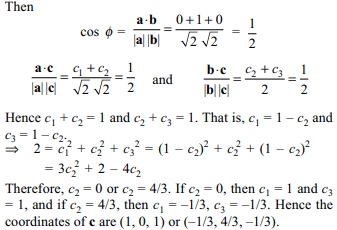
10. Let a = 2i – j + k, b = i + 2j – k and c =
i + j – 2k be three vectors. A vector in the plane of b and c
whose projection on a is of magnitude\[\sqrt{2/3}\] is
a) 2i + 3j – 3b
b) 2i + 3j + 3k
c) –2i – j + 5k
d) Both a and c
Explanation: Let the required vector be d = xi + yj + zk. For
